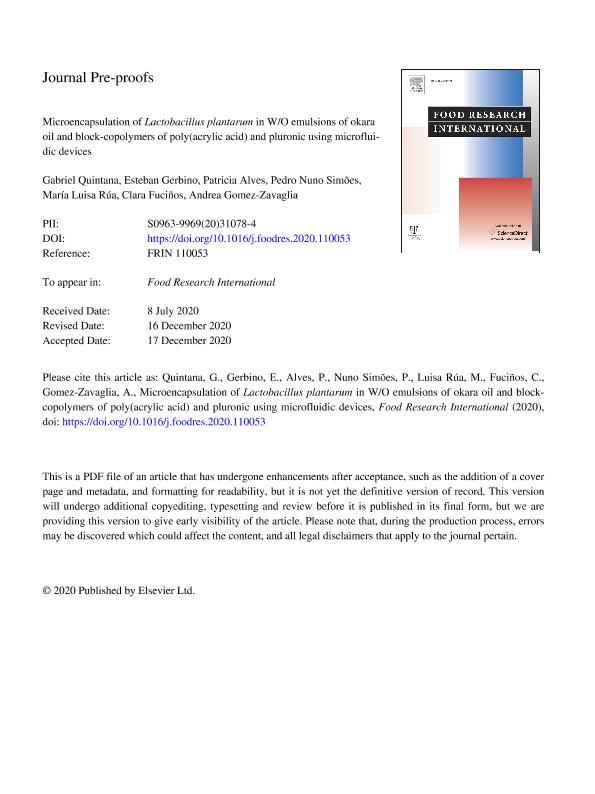Mostrar el registro sencillo del ítem
dc.contributor.author
Quintana, Gabriel Sebastian

dc.contributor.author
Gerbino, Oscar Esteban

dc.contributor.author
Alves, Patricia
dc.contributor.author
Nuno Simões, Pedro
dc.contributor.author
Rúa, María Luisa
dc.contributor.author
Fuciños, Clara
dc.contributor.author
Gomez Zavaglia, Andrea

dc.date.available
2021-04-08T12:45:47Z
dc.date.issued
2021-02
dc.identifier.citation
Quintana, Gabriel Sebastian; Gerbino, Oscar Esteban; Alves, Patricia; Nuno Simões, Pedro; Rúa, María Luisa; et al.; Microencapsulation of Lactobacillus plantarum in W/O emulsions of okara oil and block-copolymers of poly(acrylic acid) and pluronic using microfluidic devices; Elsevier Science; Food Research International; 140; 2-2021; 1-29; 110053
dc.identifier.issn
0963-9969
dc.identifier.uri
http://hdl.handle.net/11336/129604
dc.description.abstract
Okara oil is a by-product remaining from defatting okara, the solid residue generated after extracting the aqueous fraction of grounded soybeans in the elaboration of soy beverages. The goal of this work was to encapsulate the probiotic Lactobacillus plantarum CIDCA 83114 into W/O emulsions composed of a block-copolymer constituted of pluronic® and acrylic acid (PPP12) and okara oil, prepared in microfluidic devices. For comparative purposes, alginate was also included as a second dispersed phase. Lactobacillus plantarum CIDCA 83114 was suspended in PPP12 or alginate giving rise to dispersed phases with different compositions, named I, II, III and IV. Controls were prepared by suspending microorganisms in water as dispersed phase. 6-carboxyfluorescein was added as bacterial marker in all the emulsions. The presence of green dyed bacteria in the dispersed phases, inside the droplets of the emulsions and the absence of fluorescence outside them, confirmed the complete encapsulation of bacteria in the dispersed phases. After being prepared, emulsions were freeze-dried. The exposure to gastric conditions did not lead to significant differences among the emulsions containing polymers. However, in all cases bacterial counts were significantly lower than those of the control. After exposing emulsions to the simulated intestinal environment, bacterial counts in assays I, II and III (emulsions composed of only one dispersed phase or of two dispersed phases with bacteria resuspended in the PPP12 one) were significantly greater than those of the control (p < 0.05) and no detectable microorganisms were observed for assay IV (emulsions composed of two dispersed phases with bacteria resuspended in the alginate one). In particular, bacterial cultivability in emulsions corresponding to assay I (only PPP12 as dispersed phase) exposed to the intestinal environment was 8.22 ± 0.02 log CFU/mL (2 log CFU higher than the values obtained after gastric digestion). These results support the role of PPP12 as an adequate co-polymer to protect probiotics from the gastric environment, enabling their release in the gut, with great potential for food or nutraceutical applications.
dc.format
application/pdf
dc.language.iso
eng
dc.publisher
Elsevier Science

dc.rights
info:eu-repo/semantics/openAccess
dc.rights.uri
https://creativecommons.org/licenses/by-nc-nd/2.5/ar/
dc.subject
GASTRO-INTESTINAL DIGESTION
dc.subject
LACTOBACILLI RELEASE
dc.subject
MICROFLUIDICS
dc.subject
OKARA OIL
dc.subject
PLURONIC-POLY(ACRYLIC) ACID CO-POLYMER
dc.subject.classification
Alimentos y Bebidas

dc.subject.classification
Otras Ingenierías y Tecnologías

dc.subject.classification
INGENIERÍAS Y TECNOLOGÍAS

dc.title
Microencapsulation of Lactobacillus plantarum in W/O emulsions of okara oil and block-copolymers of poly(acrylic acid) and pluronic using microfluidic devices
dc.type
info:eu-repo/semantics/article
dc.type
info:ar-repo/semantics/artículo
dc.type
info:eu-repo/semantics/publishedVersion
dc.date.updated
2021-01-18T15:42:34Z
dc.journal.volume
140
dc.journal.pagination
1-29; 110053
dc.journal.pais
Países Bajos

dc.journal.ciudad
Amsterdam
dc.description.fil
Fil: Quintana, Gabriel Sebastian. Provincia de Buenos Aires. Gobernación. Comisión de Investigaciones Científicas. Centro de Investigación y Desarrollo en Criotecnología de Alimentos. Consejo Nacional de Investigaciones Científicas y Técnicas. Centro Científico Tecnológico Conicet - La Plata. Centro de Investigación y Desarrollo en Criotecnología de Alimentos. Universidad Nacional de La Plata. Facultad de Ciencias Exactas. Centro de Investigación y Desarrollo en Criotecnología de Alimentos; Argentina
dc.description.fil
Fil: Gerbino, Oscar Esteban. Provincia de Buenos Aires. Gobernación. Comisión de Investigaciones Científicas. Centro de Investigación y Desarrollo en Criotecnología de Alimentos. Consejo Nacional de Investigaciones Científicas y Técnicas. Centro Científico Tecnológico Conicet - La Plata. Centro de Investigación y Desarrollo en Criotecnología de Alimentos. Universidad Nacional de La Plata. Facultad de Ciencias Exactas. Centro de Investigación y Desarrollo en Criotecnología de Alimentos; Argentina
dc.description.fil
Fil: Alves, Patricia. Universidad de Coimbra. Facultad de Ciencias e Tecnología. Department of Chemistry; Portugal
dc.description.fil
Fil: Nuno Simões, Pedro. Universidad de Coimbra. Facultad de Ciencias e Tecnología. Department of Chemistry; Portugal
dc.description.fil
Fil: Rúa, María Luisa. Universidad de Vigo. Facultad de Ciencias de Ourense; España
dc.description.fil
Fil: Fuciños, Clara. Universidad de Vigo. Facultad de Ciencias de Ourense; España
dc.description.fil
Fil: Gomez Zavaglia, Andrea. Provincia de Buenos Aires. Gobernación. Comisión de Investigaciones Científicas. Centro de Investigación y Desarrollo en Criotecnología de Alimentos. Consejo Nacional de Investigaciones Científicas y Técnicas. Centro Científico Tecnológico Conicet - La Plata. Centro de Investigación y Desarrollo en Criotecnología de Alimentos. Universidad Nacional de La Plata. Facultad de Ciencias Exactas. Centro de Investigación y Desarrollo en Criotecnología de Alimentos; Argentina
dc.journal.title
Food Research International

dc.relation.alternativeid
info:eu-repo/semantics/altIdentifier/url/https://www.sciencedirect.com/science/article/abs/pii/S0963996920310784
dc.relation.alternativeid
info:eu-repo/semantics/altIdentifier/doi/http://dx.doi.org/10.1016/j.foodres.2020.110053
Archivos asociados
